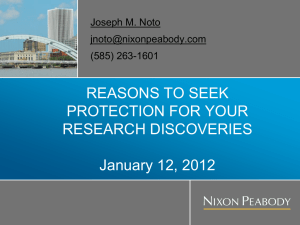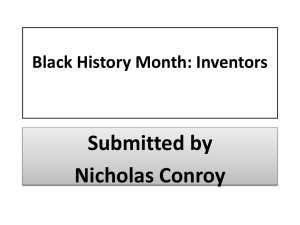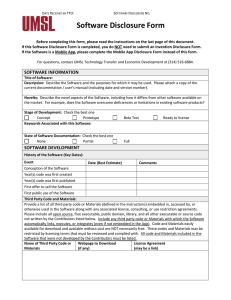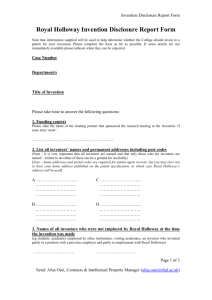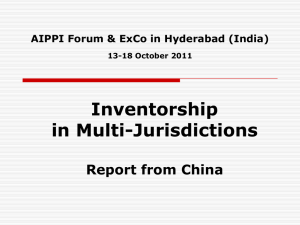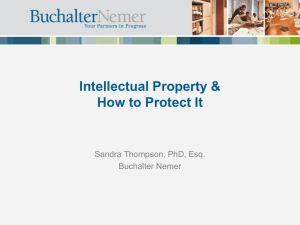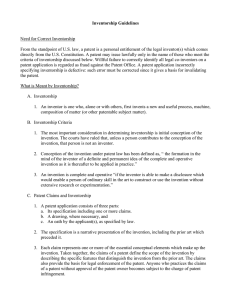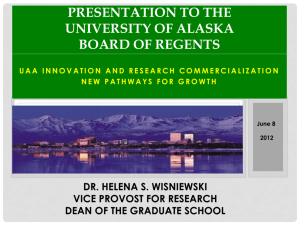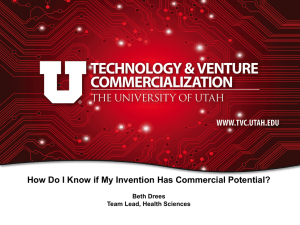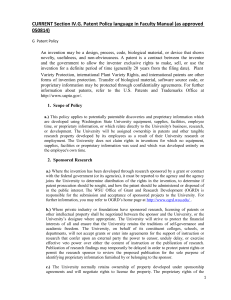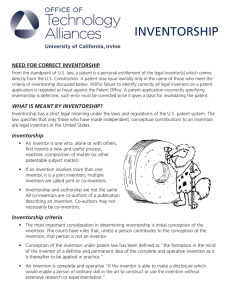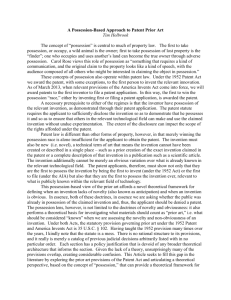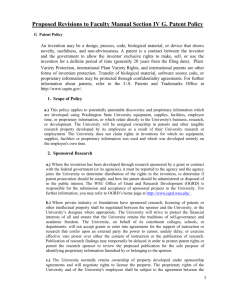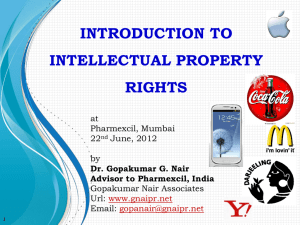Technology Development and Commercialization
advertisement
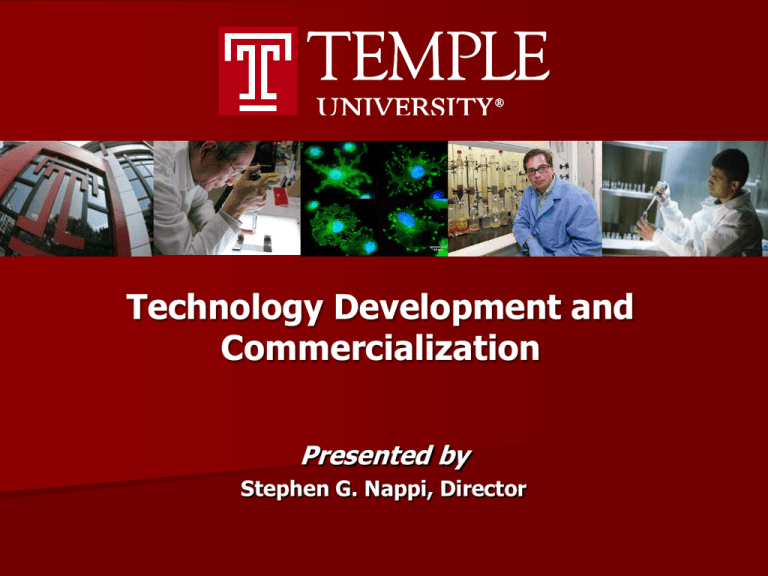
Technology Development and Commercialization Presented by Stephen G. Nappi, Director Discovering Solutions Laser-based bio and explosive threat detection • Standoff detection of explosives for security applications • Diagnosis of disease through tissue vaporization Treatment for acid mine drainage and fracking • Two-tail lipid to inhibit acidic runoff from coal mines • Applicable to the fractate and flow-back pools used in hydraulic fracturing Nanomaterials for Water Purification • Novel nanomaterials to remove emerging contaminants • Applicable to water and wastewater Discovering Solutions Biomarkers of chronic obstructive pulmonary disorder • Early indicators and treatment responses for COPD patients • Developing a rapid, cost effective diagnostic kit Determining egg quality to improve assisted reproduction • Clinical human assisted reproduction • Livestock propagation by enhanced ovulation and in vitro embryo production CLICK IMAGE FOR HIGH RESOLUTION PICTURE Cocaine analogs for the treatment of addiction • No available synthetic methods for cocaine analogs • Potential therapeutic for drug addiction, ADHD, and neurological disorders Developing Technology Licensed (selected) Technology Under Development Diagnostic technology for breast & other cancers (startup) Treatment for type II diabetes and obesity (small company) Treatment for Acute Myeloid Leukemia Fare collection technology for transit systems (large company) Endoscopic Suturing Device for Weight Loss Biosensor for detecting chemical agents (large) Devices to increase the flow rate of fluids through pipelines, including fuel and chocolate Therapeutic agents for the treatment of viral infections, including HIV, CFS, hepatitis B (small-international) Temple-Invented Products Spinning out New Businesses Diffregen, LLC • Niche therapy that converts “differentiates” cancerous cells to normal cells • Applications for skin cancers and wrinkle reduction Proplex Technologies • Diagnostic and Therapeutic for Breast Cancer • Applications for prostate, brain, and other cancers pureNano Technologies • Purification of Carbon Nanotubes for Electronics • Highest purity levels with significant cost and processing time savings Invention Disclosures 60 44 50 40 Inventions 30 29 34 34 2009 2010 51 20 10 0 2008 Fiscal Year 2011 2012 Licenses/Options Executed 8 8 6 5 5 2010 2011 4 2 0 1 0 2008 2009 Fiscal Year 2012 Gross Licensing Income $2,484,081 $2,500,000 $2,000,000 $1,218,856 $1,500,000 $1,000,000 $500,000 $300,000 $340,965 $378,207 2008 2009 2010 $Fiscal Year 2011 2012 How it Works: Key Terms Bayh-Dole Act Invention and Patent Policy Invention Disclosure Patent application (provisional, utility, PCT) Copyright U.S. Patent and Trademark Office (USPTO) U.S. Copyright Office Confidentiality Agreement License/Option Agreement Material Transfer Agreement Assessing New Inventions 1 2 3 4 • Disclose the invention via http://www.temple.edu/ovpr/ott/disclosure_process.html • Internal Review: Feedback within 4 weeks • Go/No Go • Patentability Opinion within 2 weeks • Go/No Go • Provisional Patent Protection Secured for One Year • Marketing activities initiated, partners targeted, feedback received • Go/No Go Evaluation Considerations Type of Invention Method or Process: Can it be enforced? Software: Copyright protection applies. Is a patent justified? Composition of matter (NCE): Do you have preliminary data? Device: Has a working prototype been developed? Commercial Potential Think product backwards What development steps are next? Who will buy? What company will manufacture and sell? Patent Potential Novelty: Is there anything similar in the public domain? Enablement: Can you demonstrate the invention to someone skilled in the art? Do you have the recipe to duplicate the invention? Non-obviousness: Does a single or a combination of references give other subject matter experts sufficient information to create the invention? Evaluation Considerations Inventorship Apply this test: Conception v. Execution Authorship does not equal Inventorship Courtesy inventorship can lead to invalidation Non-Temple Inventors may equal joint ownership Inventorship is a legal determination – Temple’s patent counsel will decide Sponsor Obligations Confidentiality IP Ownership and license rights Royalty sharing Publication Acknowledgement Relevant Publications Will help determine scope of patent Must be disclosed to the USPTO Working with Industry Finding the Right Company Active role in identifying external POC funds (internal funding, Science Center, Ben Franklin, BioAdvance, BioStrategy Partners) Creative marketing to identify licensing partners or entrepreneurs (social networking, conference participation) Building value internally through expert-guided development funding and business plans (Fox School, Drug Discovery Center, App Center) Attracting industry partners through business development Negotiating the Deal Creative deal-making approach for companies interested in a license Express deal-making approach for startup companies Terms based on industry standards and technology value Common negotiation tactics Income Distribution Net Income = Gross income less patenting, legal, and marketing costs related to an invention University's share of Net Income University's share of Net Income is less than or equal to $500,000 is greater than $500,000 40% to Inventors 40% to Inventors 20% to OTT 20% to OTT 14% to Department or Research Unit 4% to Department or Research Unit 6% to College or School 4% to College or School 20% to University 32% to University Startups Process Creating a Path to Market Criteria Appropriate Technologies Management Identified Potential Conflicts Resolved Agreements Executed Business Plan Developed Minimum Funding Achieved Development Milestones Completed Full License Activated Optimizing the Commercialization Process Patent Counsel EMC Evaluation Marketing Invention Commercialization Product Dev/ POC Funding Incubation Licensing/ Startup Marketplace Research Protection Top 10 Points to Remember 1. 2. 3. 4. 5. 6. 7. 8. 9. 10. Inventions should be disclosed upon conception Inventorship is a legal determination made by patent counsel Patent applications must precede public disclosure Disclosure includes journal articles, posters, oral & pre-conference abstracts Disclosure of unpublished information must be protected by a confidentiality agreement Material transfer agreements are necessary for all incoming and outgoing tangible research materials Material transfer and sponsored research agreements may contain confidentiality, publication, and intellectual property requirements Potential conflicts of interest must be reported if inventors have an interest in a spinout company An IP Rider should be signed for consulting agreements, which often conflict with the University policies and employment agreements Patents do not hinder publication Contact Information Stephen G. Nappi Ph: 215-204-5293 snappi@temple.edu www.temple.edu/research/otdc Stay Connected



